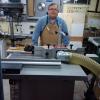First off let me thank all of you for providing me countless hours of informative enjoyable reading. I only recently stumbled into this website and I'm addicted. My boss hates you.
I'm really not much of an electrician, so any help you guys can offer would be very much appreciated. I recently bought a Laguna LT16HD bandsaw. I only have 1 220v circuit in my house, it's 30 amp (at least that's what it says on the breaker) and it's running to the laundry room. Lucky for me, my garage shop shares a wall with the laundry room. I tapped into it to add a 220v outlet in the garage. I assumed I could splice into the wire I ran across the garage attic to add more outlets as necessary.
My next purchase is going to be a Dust collector (reading these forums has me convinced I need an Onida and a second job) and most of the better units also require 220v. My initial reaction was no problem, I'll just run another outlet into the garage. But will I be able to run both my bandsaw and a DC at the same time on the same circuit? What if the wife happens to be using the dryer? Will i be able to run either unit? Thanks in advance for your thoughts!





 Reply With Quote
Reply With Quote







